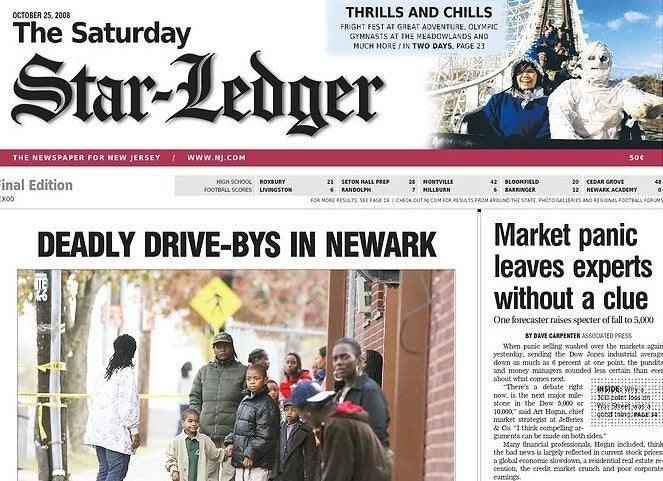
In the snarkoff recently about my holding journalists to account for the state and fate of journalism, commenters asked with good reason when I say journalism will be done, how we're going to watch the government, and where the money will come from. I don't have answers to those questions; I have guesses, notions, wishes. All I know is that we must explore and experiment with many models to find and invent what will work (that's why we held the New Business Models for News Summit at the CUNY Graduate School of Journalism).
It's fair to expect me to put forward scenarios for the future of news. In a sense, that's all I ever do on my blog, but there's no one permalink summarizing my apparently endless prognostication. So here is a snapshot of - a strawman for - where I think particularly local news might go. What follows is just a long - I'm sorry - summary of what I've blogged over time and an extension of the one model I think we need to expand coming out of the conference, where one lesson I took away is that news - on both the content and business side - will no longer be controlled by a single company but will be collaborative.
* The next generation of local (news) won't be about news organizations but about their communities. News is just one of the community's needs. It also needs elegant organization. News companies and networks can help provide that. The bigger goal is to provide platforms that enable communities to do what they want to do, share what they want to share, know what they need to know together. News will become a product of the community as much as it is a service to it.
* The local news organization inevitably will be smaller because it no longer holds a monopoly in a scarcity economy. I've been accused of celebrating that shrinkage at the summit. That's an artless and deliberate mischaracterization of what I said. I lauded the courage of the people in the room to start from the ground up and figure out what they could afford - to at last be realistic. In a market the size of Philadelphia, based on feasible audience and ad revenue, rather than a 200-400-person newsroom, they came out with 35 people and the job descriptions were different: lots of content creators, few editors, and the addition of people to work with the community. That was a start.
* News will emerge from networks. As I said after the conference, no one believes that 35-person staff can cover Philadelphia as the 300-person newsroom did; they will have to collaborate with the community, with, we hope, a network of a thousand or thousands. Some people will freely contribute to the news network's efforts, recording school-board meetings for podcasts, say. Some will be former staff journalists now on their own. Many people will operate independently, as Deb Galant does in New Jersey. Some will be bloggers. Some will be freelancers. Many will need to be paid or they won't join.
What I hope emerges are small, local Glams that provide support to members of the networks - ad revenue, content, promotion, training - so they grow. This is the fabled and as yet unattained hyperlocal news network. That support will come from those new job descriptions (editorial and business) in new news organizations and from other companies that build platforms. It's hard to be Deb and operate totally alone; I hope that once networks exist, they will enable and encourage more to start reporting and join in. And that, I hope, can expand journalism past the necessary limitations of the old newsroom. Journalism can grow. But first, we have to create the platforms and networks for local news that will help it grow.
* The heart of the work of local news organizations will be beats. Dogging a beat with reporting is the unique value a news organization can contribute to the press-sphere. Those beats will surely include local government but likely should not include areas that are not local, like science or movies. Beat reporters will not just be producing stories. They will open the process of news in blogs. They will work collaboratively with experts, bloggers, and people in the community (see: Jay Rosen's beatblogging).
* Editing will change. Editors will become more curators, aggregators, organizers, educators. Their jobs will be less about controlling a flow than encouraging and improving creation.
* Some - only some - journalism will be supported by the public. I have high hopes for David Cohn's Spot.us with readers supporting reporters' stories. We all hope NPR and its model can prosper and grow (though at a local level, that will happen only if stations create strong local value). Who isn't also rooting for ProPublica? I hope its model can extend investigative reporting to local markets with local foundation and public support. See Richard Perez-Pena's report on some such efforts.
* Investigative journalism will continue from the news organization and from collaborative efforts (see Ft. Meyers with its data-based investigations and Team Watchdog). The fear I hear constantly is that investigative journalism will be the first form to die. That would be foolish and news organizations will learn that. In a link-and-search economy, you must create unique content with strong value to get attention and audience. Investigations matter more than ever; they will have greater audience and thus business benefit. Note well that investigative and public-supported journalism will amount to a small proportion of the total journalistic effort. But also note that the resource that goes to investigations in traditional newsrooms today is also tiny (I'd estimate less than 1 percent). The seed of much investigation will still come from beat reporting and now it will also come more often from the public; execution will come from reporters and in collaborative projects. There are also new tools for investigators, starting with data analysis. With strong beat reporting, collaborative projects, and some public support, investigations could grow. But we can never have enough.
* Do what you do best and link to the rest will be a foundation of the future architecture of news. This is a necessity of efficiency - no one can afford to waste resources on commodity news - but also a necessity of the link economy, for it is through others' links that original journalism will get attention and audience and the opportunity for monetization through advertising. Linking to journalism at its source - rather than matching it or rewriting it, as we have done - will become an ethic, a moral imperative of the new journalism.
* Specialization will take over much of journalism. We'll no longer all be doing the same things - commodifying news - but will stand out and contribute uniquely by covering a niche deeply. Local newspapers, I believe, must specialize in being local and serving local communities. But journalists can specialize in other areas and links will feed them with audience. I use Brian Stelter's old CableNewser.com as an object lesson here - he could cover cable news with more depth than any trade publication. See also Ed Silverman's Pharmalot, which covered the pharma industry for the Star-Ledger but should and will become the source for the industry worldwide (while still interesting locals in the industry).
* Reverse syndication presents one possible model for supporting deep, specialized reporting of broad interest by national news organizations. For example, The LA Times should do a brilliant job covering the entertainment industry and as other papers and magazines lose their LA bureaus and cancel old syndication deals, the Times should tell them all to send audience to its coverage (giving back a share of revenue generated as a result) or the Times may share that coverage on other sites with its ads attached to help pay for it. The same can be true of Washington coverage; that is what Politico has started. The same will happen with foreign bureau coverage (see The Time's Baghdad bureau, which the paper often tells us costs $3 million a year - more traffic won't fully support it but it could help; see also Charlie Sennott's international startup). The old syndication model will die, for there's no longer a market for the second copy of a story. And the wire-service model is in jeopardy, for it commodifies news and cuts links to the journalism at its source and is expensive. I think reverse syndication as well as new ways to share original journalism are worth exploring.
* News will find new forms past the article, which will include any media, wiki snapshots of knowledge, live reports, crowd reports, aggregation, curation, data bases, and other forms not yet created.
* News organizations will be disaggregated as many functions are split off or outsourced. They will jettison production and distribution, the nonjournalistic, nonsales departments that add up to 60 percent of a paper's cost structure.
* News organizations won't be the only companies involved in news. Just as journalism will be collaborative, so will sales and technology be. EveryBlock will organize data; Outside.in will organize geo content; Daylife will organize news; Publish2 will organize links; Digg will help the crowd curate; Clickable will help sell ads; Google will serve ads; YouTube and Brightcove will serve videos; and on and on. (Disclosure: I'm a partner at Daylife and board member at Publish2.)
* Revenue will still come from advertising. The best hope is to find ways to serve a new population of small advertisers who never could afford to use newspapers before along with some aggregation of audience for regional advertisers. (See Fred Wilson's prescription from the summit.)
This is just one scenario for one slice of journalism. I also will talk about national and international coverage, collaborative tools, APIs and other new means of distribution, and more. I wonder how we can make journalism using a million phones recording and broadcasting video (around any nation's censors) or Mechanical Turk (a thousand eyes digging into documents) or algorithms mining newly transparent government documents....
Note well that none of this is new. The essential functions of journalism - reporting, watching, sharing, answering, explaining - and its verities - factualness, completeness, fairness, timeliness, relevance - are eternal, but the means of performing them are multiplying magnificently. That is why I so enjoy teaching journalism, because we need no longer pick a medium and its tools for a career but can select them every time we need to tell a story - and because journalism is no longer about preservation (it never should have been) but is instead about change and growth.
Could journalism die? Yes, but I have faith and optimism that it will survive, evolve, and grow. I believe there will be a growing market demand for journalism; I know there is a growing need.
In the day - when I was starting in this business and covered him - the late Mayor Daley of Chicago used to respond to his critics saying, "What trees do they plant?" Say what you will about him, Hizzoner planted trees. This is my sapling. But that's all it is. We need many, many scenarios and - far more important - we need people in the position to execute, experiment, adapt, invent, and share what they do ... fast.
